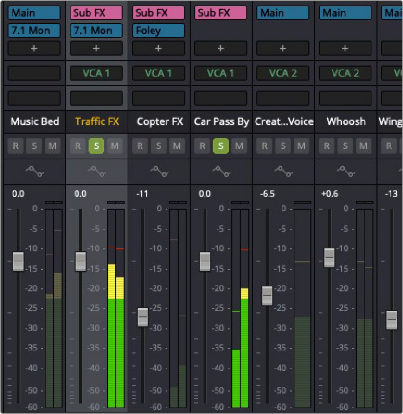
< Previous | Contents | Next >
By default, “Pre fader metering on tracks” is unchecked (disabled), setting the metering on channel strips to be post (after) the fader level and mute button. For example, if the source audio file has peaks that are hitting -2 dBFS, and the channel fader is lowered from 0 to -10, then the peaks that show on the meter will now be at -12.
When pre-fader metering is on, the metering point is set to be before the fader, and is not affected by the fader’s position. However, the meter is affected by clip gain settings or key framing as these level changes occur before the clip’s signal enters the mixer’s signal path.
With pre-fader metering, you could lower the fader to be fully off (minus infinity) and the meter will still read the level of the source signal. This allows you to always be aware of the source signal and what it is doing before being altered by mixer’s controls or processing.
Many video editors prefer to work with post-fader metering, but most audio mixers prefer to work with pre-fader in order to be aware of what the actual source level is at any time.
Solo and Pre-fader Metering
When pre-fader metering is enabled, soloing one or more tracks will show a lighter “ghost” version of meter activity on non-soloed tracks, allowing you to always see audio levels on tracks that are muted by the soloing process. This makes it easy to focus on tracks that are actually audible while still seeing activity on those that are not.
If pre-fader metering is off (the default), when one or more tracks are soloed, no metering occurs on tracks unsoloed tracks.

![]()
Pre-fader metering with light shaded meters on non-soloed tracks